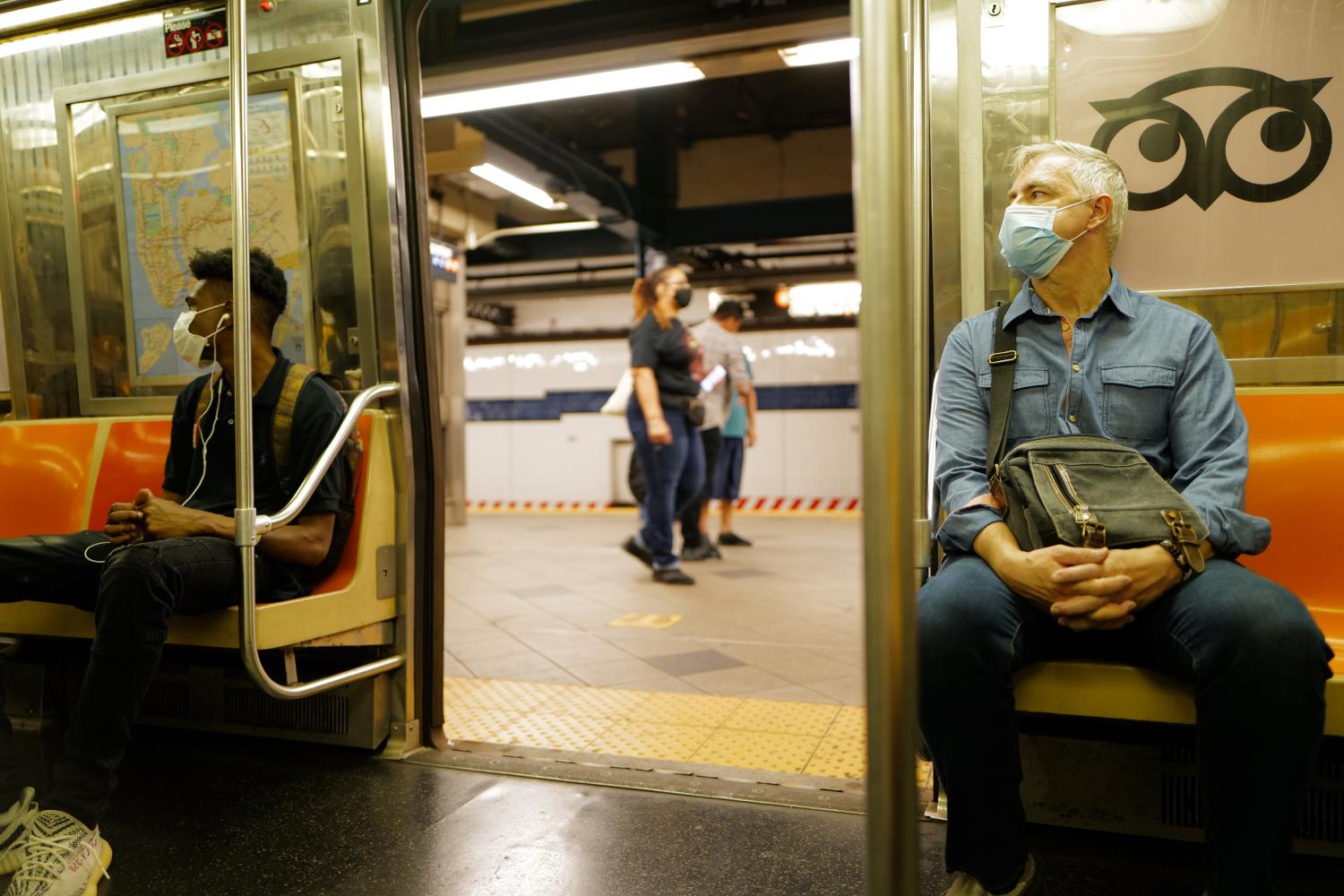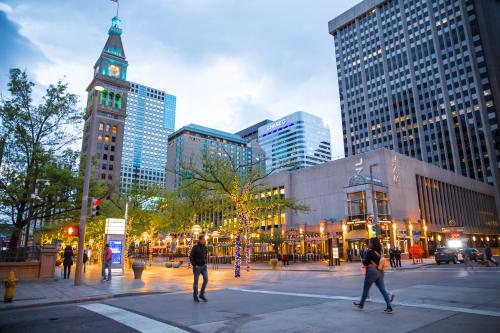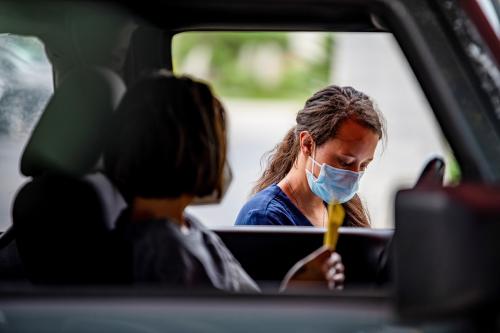Contents
- Uneven national and regional shifts in COVID-19 cases
- A state-level look at where COVID-19 surged
- COVID-19’s county-level impact: Urban versus rural, blue versus red
- Preparing for the next 12 months
Over the past 12 months, the COVID-19 pandemic has taken a long and winding road, ranging from modest upticks and downticks to huge, nationwide spikes. Virtually all parts of the U.S. have experienced COVID-19 surges at some point, especially after the massive spikes in the fall and early winter. Although new cases have fallen in the last month, per capita new case levels—nationally and for many states—are higher than they were in late summer, and the potential for further surges is real.
Thus, it is important to monitor these shifts in light of what has happened in the past year, even as the distribution of effective vaccines is now in progress. The analysis below tracks how COVID-19 has spread across regions, states, and counties over the past year, with an eye toward understanding the context of the most recent outbreaks.
Uneven national and regional shifts in COVID-19 cases
This essay measures COVID-19’s path across the country by tracking new monthly cases per 100,000 residents nationally from March 2020 through February 2021. Rates for the nation are shown in Figure 1.*

The modest rate of 56 new cases per 100,000 residents in March 2020 rose to beyond 200 from April to June, and spiked sharply to over 500 in July. The end of the summer saw a dip down to 366 in September. However, this lull was short-lived; October saw a return to the 500-plus threshold, followed by a doubling of that rate to 1,335 new cases per 100,000 residents in November, 1,941 in December, and 1,877 in January. Those last two months’ rates have been attributed to group gatherings and lax social distancing during the Thanksgiving to New Year period.
In February 2021, another lull set in, with national new case rates dropping to 729 per 100,000 residents. But the longevity of this recent lull is open to question, since the previous August to September lull was short-lived.

Figure 2 provides a 12-month overview of COVID-19 rates for each of the four census regions. The winding path started with highest case rates in the Northeast, then moved to the South and West regions, which recorded especially high new case rates in July. In August and September, Midwest rates began to rise and dwarfed those of other regions in October and November. By December, the other three regions, especially the West, showed sharp gains and remained high in January, while Midwest rates fell from those of the previous two months.
In February 2021, new case rates in all four regions took a substantial downward fall from the holiday surge. Nonetheless, February new COVID-19 case rates for the Northeast, South, and West regions were still higher than rates in most months prior to November. The Midwest’s February rates were lower than in any month prior to September.
A state-level look at where COVID-19 surged
A look at individual states provides a more granular view of these shifts. The maps below depict which states exhibited new COVID-19 rates of: 1) Fewer than 500 cases; 2) 500 to 1,000 cases; 3) 1,000 to 2,000 cases; and 4) 2,000 or more cases, all per 100,000 residents on a month-to-month basis (see downloadable Table A).
March to May 2020: Westward dispersion from Northeast states
In March, not one state saw a COVID-19 case rate exceeding 500 per 100,000 residents, although New York—with a rate of 392—came the closest by far. In April, New York and New Jersey zoomed to rates exceeding 1,000 cases per 100,000 residents, with the New England states of Massachusetts, Connecticut, and Rhode Island (as well as Washington, D.C.) seeing rates of 500 or greater.
By the month of May, COVID-19 rates in the Greater New York metropolitan area slowed down, such that the new case rates for New York, New Jersey, and Connecticut dropped below 500, not to return to those levels until November. Still, Illinois (reflecting rises around Chicago) and Maryland (including Baltimore and suburban areas outside Washington, D.C.) as well as Nebraska joined the ranks of places with new COVID-19 cases exceeding 500 per 100,000 residents that month.
June and July 2020: Rise of southern states
June was a transition month, in the sense that only Arizona exceeded new case rates of 500 per 100,000 residents. But just below the Grand Canyon State were rising rates in several southern states that entered that category in July.
In fact, the national July rise in new COVID-19 rates was largely due to southern states. Florida led, with a rate exceeding 1,400 new cases per 100,000 residents. Four other southern states—Louisiana, Mississippi, South Carolina, and Alabama—showed July rates exceeding 1,000 cases. Another six states—including Texas, Georgia, and North Carolina—showed rates exceeding 500 cases. Several western states—including Nevada, Idaho, California, and Utah—also exhibited high rates, raising this region’s profile in July. Arizona led here, with a new monthly rate of 1,300 cases per 100,000 residents.
Late summer and fall: A Midwestern surge
While new COVID-19 rates tamped down somewhat in August and September nationally, states in in the Midwest joined states in the South in exhibiting higher case rates. Among the latter, North Dakota, South Dakota, Iowa, Missouri, and Kansas registered rates exceeding 500 per 100,000 residents in August. In September, North Dakota, South Dakota, Wisconsin, and Iowa showed the highest new case rates of all states, followed by a mix of other states in the Midwest, South, and West.
It was in October and especially November that national new COVID-19 rates began to rise dramatically, with Midwest states in the top ranks. In both months, North Dakota and South Dakota led with new monthly COVID-19 rates, exceeding 2,600 cases per 100,000 residents in October and 3,800 in November. In October, 10 states—all in the Midwest and West—registered new rates exceeding 1,000 cases per 100,000 residents. In November, 17 states in those same regions exhibited rates exceeding 2,000 cases per 100,000 residents.
November through January: A national saturation
When using a benchmark of new monthly COVID-19 rates exceeding 500 per 100,000 residents, 47 states (in addition to Washington, D.C.) representing all regions of the country reached that level in November. In that month, several states which had dropped below this benchmark since May—including New York, New Jersey, Maryland, Washington, D.C., and most of New England—returned. Pennsylvania, Delaware, Virginia, West Virginia, Oregon, and Washington reached this benchmark for the first time since the pandemic began. Only three states—Maine, Vermont, and Hawaii—did not register new case rates exceeding 500 per 100,000 residents in any of the first nine months of the pandemic, though each exhibited their highest rates in November.
The pandemic’s grip on the nation was even stronger in December. In that month, 21 states registered new COVID-19 rates of at least 2,000 cases per 100,000 residents, with another 26 states showing rates between 1,000 and 2,000 cases. Although states in all regions are represented in the highest of these new COVID-19 rate categories, states in the West and South comprised the bulk of December’s hardest-hit states, with California, Arizona, Utah, and Nevada being four of the top eight. Rhode Island—with a rate exceeding 3,000 cases per 100,000 residents—led all others.
In January, gains in new COVID-19 rates were similarly prevalent in most parts of the country. Forty-three states had new COVID-19 rates of at least 1,000 cases per 100,000 residents and, in 16 of those, the rates exceeded 2,000 cases. Arizona topped all others, with a new case rate exceeding 3,000 per 100,000 residents. Nine of the 16 states with highest rates were located in the South. Notable as well is the rise in New York and New Jersey, both of which registered new case rates exceeding 2,000 for the first time.
The February drop-off
As the national new COVID-19 case rate fell from January to February, so too did its geographic spread. Over the month of February, no states reached more than 2,000 cases per 100,000 residents, and only four—South Carolina, Rhode Island, New York, and New Jersey—showed rates exceeding 1,000 (though North Carolina and Texas did not fall far behind). Furthermore, 17 states registered rates that were less than 500 cases per 100,000 residents—the largest number of such states since October, with all but two of those states located in the Midwest and West regions.
While February represented a welcome retreat from the pervasive COVID-19 spread during the holiday months, case rates for each state still stood well above most months prior to the fall of 2020 (see downloadable Table A).
COVID-19’s county-level impact: Urban versus rural, blue versus red
Just as COVID-19 case rates broadened across states in the past year, they did so as well for the nation’s 3,100-plus counties. Table 1 provides a month-by-month overview of the rise and fall in the number of counties that achieved monthly new case rates exceeding 500 per 100,000 residents between March 2020 and February 2021.

In March 2020, just 10 counties met the 500-plus new monthly COVID-19 case rate threshold. Because they included populous counties in the New York metropolitan area, these 10 counties contained 11 million people, or 3.4% of the U.S. population. The number of counties that crossed this monthly threshold stayed below 300 (and no more than 15% of the U.S. population) until there was a broader spread across the South and other parts of the country in July. Then, more than 1,000 counties—representing 44% of the U.S. population—showed new monthly COVID-19 rates exceeding 500 cases per 100,000 residents.
While the number of such counties stayed similar in August and September, there was a switch from larger urban counties to smaller-sized metropolitan and nonmetropolitan areas. As a consequence, the overall affected population was reduced; in September, only 20% of the U.S. population lived in areas with new COVID-19 case rates exceeding 500 per 100,000 residents.
This changed from October through January, when the number of counties crossing the 500-plus case threshold exceeded 2,000, peaking at 3,000 in December. Moreover, in both December and January, these counties housed 99% of the nation’s population. In fact, in each of those months, two-fifths of the U.S. population lived in counties where new COVID-19 cases exceeded 2,000 per 100,000 residents. Some of this is due to spikes in counties located in some of the nation’s largest metropolitan areas, including New York, Los Angeles, Miami, and Dallas.
As with states, there was a tamping down of new COVID-19 case rates at the county level in February. That month, the number of counties with at least 500 new cases per 100,000 residents fell below 2,000. Still these counties were home nearly three quarters of the U.S. population and, in most of them, their February 2021 rates were higher than for much of 2020.

The urban-rural dimension of COVID-19’s county spread took different paths over the course of the last year. This is illustrated in Figure 3, which shows trends in monthly new case rates using a classification of urban counties developed by the Brookings Institution.**
At the beginning of this 12-month period, large urban core counties—dominated by those in metropolitan New York—showed the highest COVID-19 rates. This shifted over the summer, as rates in large suburban, smaller metropolitan, and nonmetropolitan counties started to catch up to those in large urban cores.
Toward the late summer and fall, case rates in small metropolitan counties and especially nonmetropolitan counties began to take off. While all categories of urban areas showed sharp rises in new monthly COVID-19 rates in November, the monthly rises for nonmetropolitan counties were stunning. Between August and November, nonmetropolitan and small metropolitan counties displayed substantially higher rates than their more urbanized counterparts.
This pattern shifted in December, as new COVID-19 case rates for large urban core and suburban counties began to rise. In that month, all urban categories showed rates that were at or approaching 2,000 cases per 100,000 residents. Yet, in January, it was rates in smaller-sized counties that began to fall off. Even in February, when rates were lower across the board, larger urban core and suburban counties displayed higher new COVID-19 case rates. Some of this was due to the pandemic’s rebound from earlier in the pandemic year; for example, although New York City’s new case rate declined between January and February (from 2,135 to 1,395 new cases per 100,000 residents), its February new case rate still exceeded the city’s previous rates in all months prior to January except for its earlier peak in April 2020.

While November’s presidential election is well behind us, there is still interest in how COVID-19 impacted counties that lean Democratic versus those that lean Republican. Just as the urban and rural dimensions of new case spread changed directions over the year, so too have the rates associated with “blue” Democratic counties (those won by Joe Biden) and “red” Republican counties (those won by Donald Trump).
As the 2020 presidential campaign began, the picture painted last spring (and consistent with the data) was that that the pandemic was largely an urban, “blue county” phenomenon. However, a comparison of new monthly COVID-19 case rates for counties that voted for Joe Biden with those that voted for Donald Trump shows a sharper rise in Trump county cases in October and November.
As displayed in Figure 4, Biden counties registered higher monthly new case rates from March through July. This flipped modestly in August, when Trump counties exhibited higher new case rates. Yet, in September and especially in the months surrounding the election, Trump counties registered noticeably higher new COVID-19 rates than Biden counties.
This should not be surprising, given that nonmetropolitan counties—a stronghold of Trump’s base—showed especially large gains in new COVID-19 cases. Whether these Biden-Trump county disparities affected the election is open to debate. Clearly, new COVID-19 cases rose in the month before election—especially in Trump counties. Perhaps this somewhat dampened Trump’s still strong support in some of the swing states that Biden won, particularly in suburban and small metropolitan counties where COVID-19 cases were also on the rise.
Although Trump counties still showed higher new COVID-19 rates in December, the gap between rates for blue and red counties began to narrow as larger-sized, generally blue counties showed case rate increases. In both January and February, the gap was negligible. Recent months’ wide COVID-19 spread to all parts of the country along with this narrowing gap suggests that any politicization of the response due to perceived different experiences of largely red or blue communities is not warranted.
Preparing for the next 12 months
The COVID-19 pandemic’s winding path over the past year has been a painful experience for most Americans. What started as a highly localized, urban phenomenon eventually spread to all regions and types of areas—be they blue or red, North or South, urban or rural.
It is important to recognize that during several periods in the last year—such as mid-May or August to September—trends suggested that the pandemic’s impact might be dissipating. Many observers also felt that “their” part of the country—be it in the nation’s heartland, or a rural or exurban community—might be immune.
But the statistics show that the COVID-19 pandemic—with its unanticipated twists and turns—cannot be underestimated. Summer spikes in the South, autumn spikes in small-town America, and the more recent re-emergence in large metro areas all suggest that more surprises may be on the way.
To be sure, the widespread distribution of vaccines along with February’s case rate downturn are causes for optimism. However, as shown above, even February’s rates of new COVID-19 transmission are higher —and often substantially higher—than those observed prior to last fall’s surge, and thus cannot be dismissed. For example, New York state’s rate of 1,151 new cases per 100,000 residents is higher than all but three of its earlier monthly rates. In Texas—where Governor Greg Abbott just ended a statewide mask mandate—the February rate of 959 new cases per 100,000 residents is higher than in any month prior to October.
The next 12 months may very well tell a different and much more positive story. However, a close look at the numbers from last year sends the strong message that continued caution and adherence to health expert guidelines are still very much in order.
*Monthly COVID-19 case counts come from The New York Times.
**This classification of U.S. counties, developed by the Brookings Metropolitan Policy Program, depicts urban cores and large suburbs within the 100 largest metropolitan areas, as well small metropolitan and nonmetropolitan counties.







